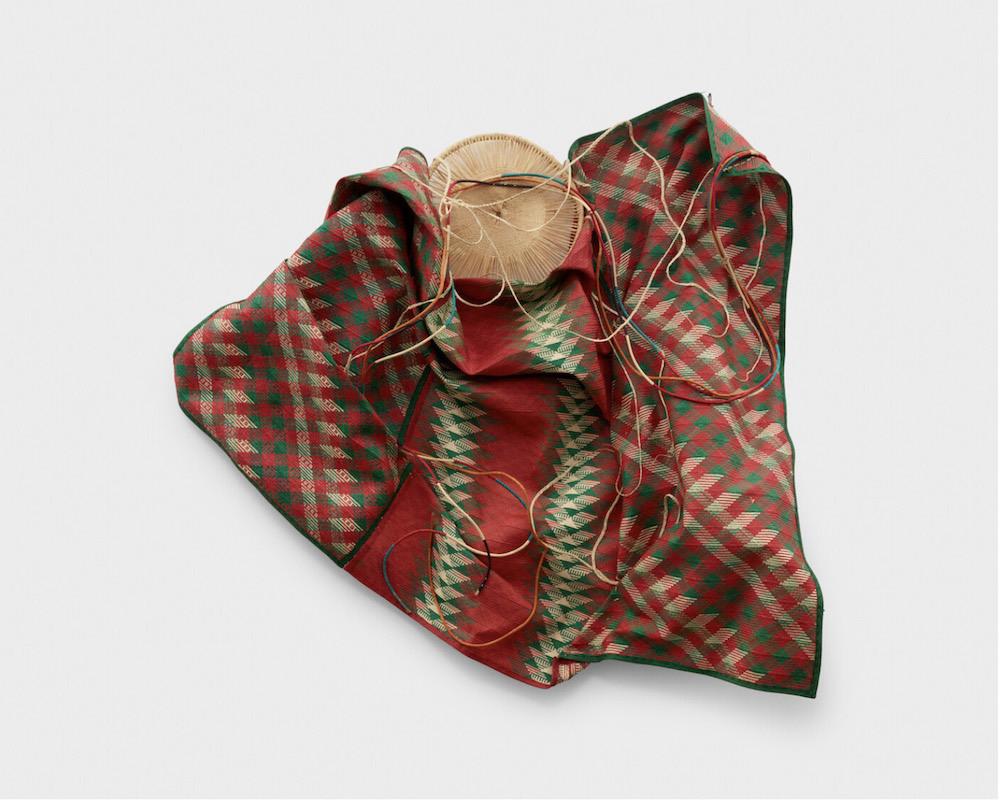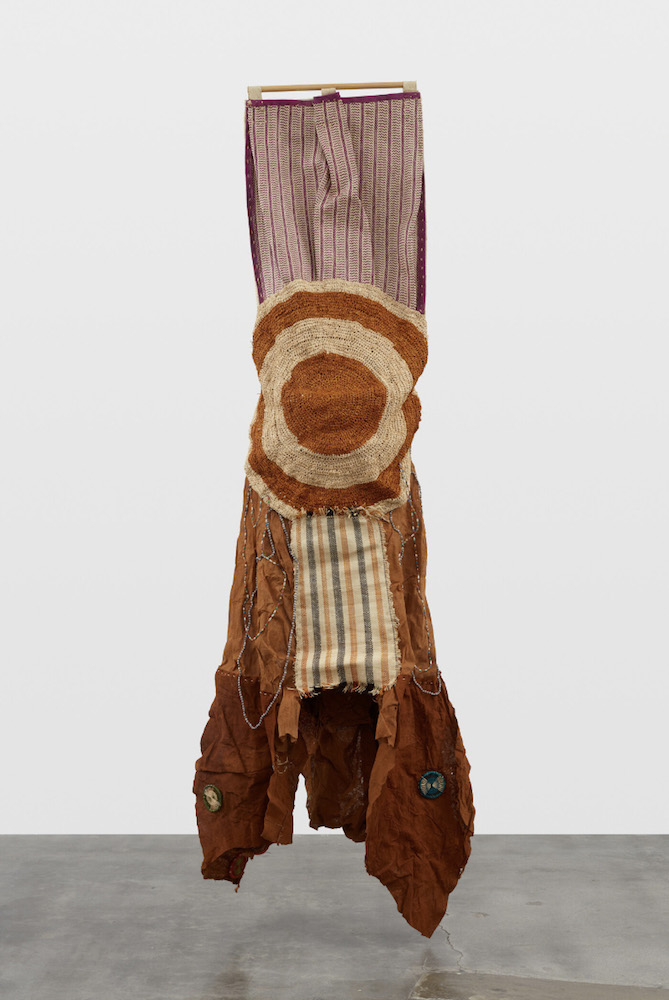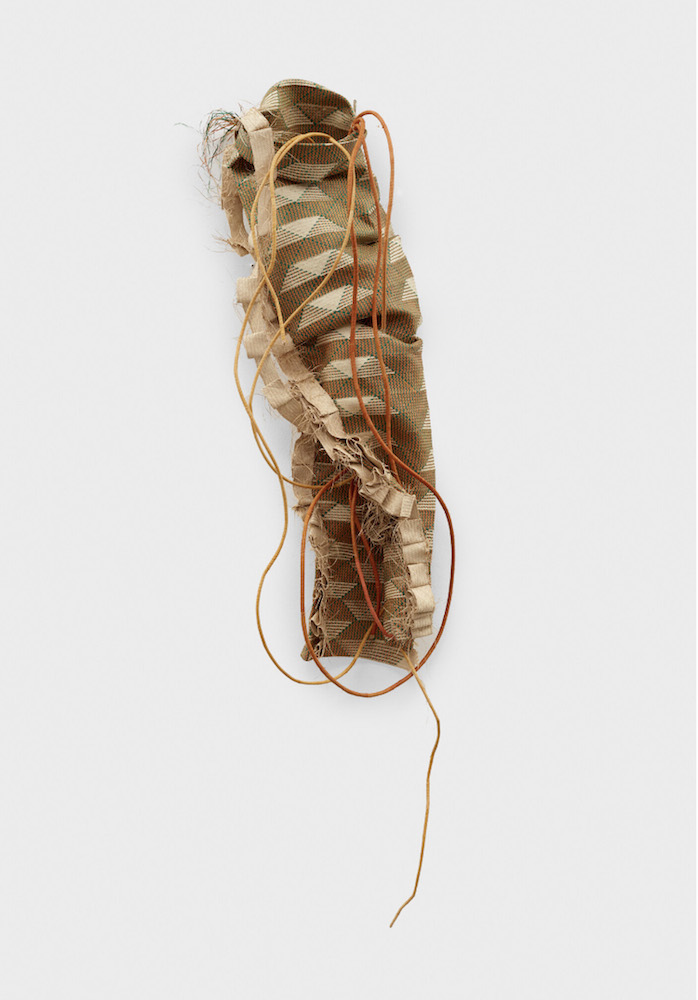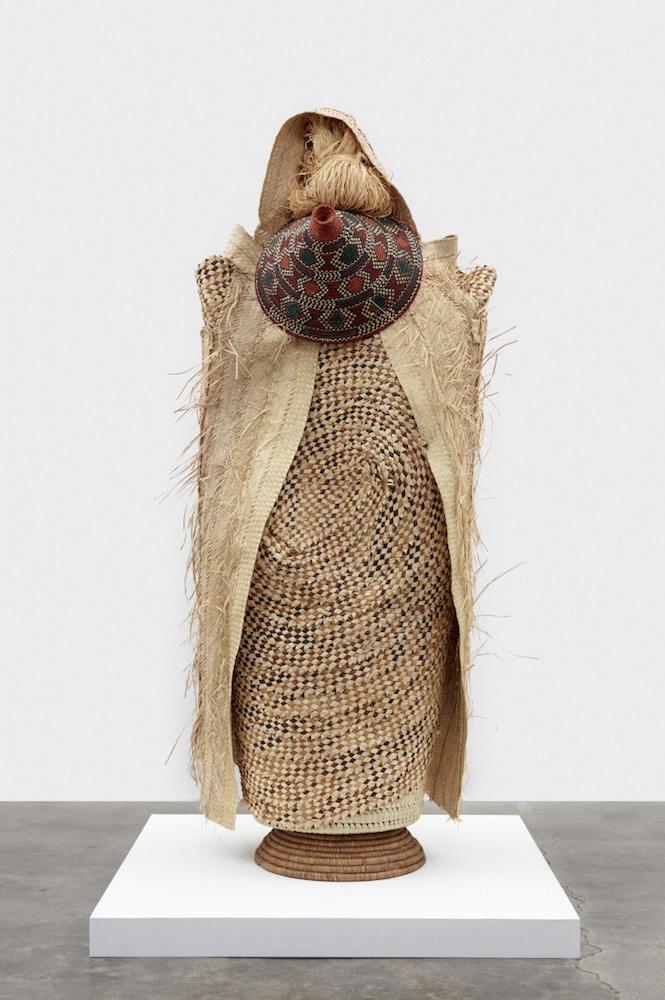You’re in an otherwise familiar room or space, struck by how unusually airy and refreshed it seems. At the same time, wafting through the interior that constitutes your “mind’s eye,” you’re struck by a sense that, in one way or another, you’ve been here before. The art itself is like nothing you’ve ever seen before; but again, oscillating and permeating through it all is the sense of something that has come before. Then the title given to the exhibition impresses itself upon the visitor: “I am here.” The whole of it is all here and now—as the viewer awakens to the realization of everything that has happened throughout the past 40 or 50 years, what is happening in the present, and what we can see will happen in the next four or five decades.
On the second-floor gallery at what was then Blum & Poe—now BLUM—the show’s title (like the titles of the individual works themselves) was rendered in Alur, the western Nilotic dialect spoken in the southern West Nile and Great Lakes region of Uganda—“A NI EE” (I am here). The Ugandan artist—Acaye Kerunen—was there, too (chicly suited in shocking pink), with videographer Cyril Ducottet, her collaborator in producing her 2023 three-channel video installation, Iwang Sawa, or In the eye of time.
Time is a theme that recurs in her work—drawing attention to both the process through which the work is crafted and constructed into art, the raw and finished materials with which it’s made, the terrain where many of those raw materials originate, and the time reclaimed by the artisans themselves in refashioning or deconstructing otherwise utilitarian materials into the stuff of art. In playing on this connotation of “burning time”—a colloquial expression in the Alur dialect, implying “wasting time”—the work also becomes an implicit retort to the legacies of patriarchy and colonialism that once relegated women—and the entire region—to serving the ends of others, whether merchants on the other side of the world, or farming and trading men who effectively governed their lives.

Acaye Kerunen, ATUK–Alur for “I have taken to Flight,” 2023. Photo: Evan Walsh. Courtesy of the artist and BLUM Gallery.
Downstairs, the visitor was invited to pause at a tent-like installation—Kendu (or “hearth”), constructed mostly of barkcloth draped over a small hive-like dome structure—for a coffee or tea, as if to similarly burn time, or perhaps more accurately, contemplate the time burning outside. (Kerunen has collaborated on several iterations of this work.)
There are few such pauses for Kerunen due to the growing praise of her work. Nevertheless, she was able to make a few comments by email in response to my queries. I mentioned the implicit dualities and ambiguities in the works (and their titles) and wondered what an “eye of time” view might be from such a perspective. Her remarks were sometimes quite direct, but also occasionally as enigmatic as the works I referenced. In Aneni (“I see you/I have seen you”), a circle of banana-rind fiber floats in a rectangular field of blackened barkcloth, seemingly held in place by three raffia bracelets. The circle is looped over three times into irregular intersecting figure eights—as if testing the proposition encapsulated in the title. It’s tempting to draw comparisons to what might superficially be regarded as precedents from the
European or American modern canon (Jean Arp in this instance), but between material and mathematical dimensions, Kerunen toys with and challenges the viewer’s assumptions and expectations. The way we see, and what or who are seen, are constants in the dialectic of art, but the intersection of media and the moment magnify the significance of what is playing out in the work.
Themes of metamorphosis and flight run through the work, beginning with the beautifully articulated chrysalis-like Nyalak (2023)—or “The one who crawls about”—with braided cords flailing around it as if to lasso its “caterpillar” into a safe berth or just failing to prevent its escape. In Atuk (2023)—or “I have taken to Flight”—a beautiful piece of raffia woven into grids of interlocking red and green lozenges is draped and turned as if a bat, bird or butterfly poised to do just that.

Acaye Kerunen, DAADWONG–Alur for “The Matriarch,” 2023. Photo: Evan Walsh. Courtesy of the artist and BLUM Gallery.
Kerunen’s work as an artist and curator is only one large part of a career dedicated to communicating her ideas about ecosystems, societies, African Great Lakes and wetlands of Uganda—which notwithstanding that country’s efforts at preservation are under threat no less than other regions of the continent.
“I grew up like a jungle girl,” said Kerunen, “foraging for vegetables, climbing trees, knowing where to find the best fruit. I realized later how fast my little green world was disappearing. Wetland mass coverage has been reduced by more than half in the last 10 years. This is scary.”
These Ugandan regions have long sustained a thriving craft culture that includes the kind of weaving and basketry that provide the foundation of materials used in the production and assembly of Kerunen’s works, and she has drawn on some of the best of these craftswomen in fabricating them. Depending on the work or project, she may have anywhere from seven or more women working with her, some of whom are well on their way to becoming artists themselves.

Acaye Kerunen, NYALAK–Alur for “The one who crawls about,” 2023. Photo: Evan Walsh. Courtesy of the artist and BLUM Gallery.
There was a tension between the cultural and even geographic specificity of the materials and their reimagination and reconfiguration in the works, which brought me back to her comment regarding “more sides to familiar narratives.” Was there a larger, more contrapuntal narrative or commentary here? “Yes. Social and political revolution. My personal growth and liberation from many things, people, contexts.”
Reexamining how that counterpoint plays out in the individual works, the viewer sees just how the personal narrative Kerunen has constructed in “A NI EE” is bound in the Kampala hills, Ugandan wetlands and with her own family’s story—a kind of matrilineal mythos.
“I turned to poetry and imaginary worlds for escape and to engineer my own kind of fair world,” said Kerunen. Art was first a vehicle for “competing mostly with my elder sister for the selective attention of my mom. Later, it was to earn her love, since she was an artist herself. Still later it became rebellion—a way to spite her by making things in ways I knew would trigger her attention. Now I do it for me—as catharsis, for healing, for joy. I love joy.”


